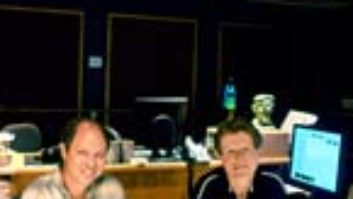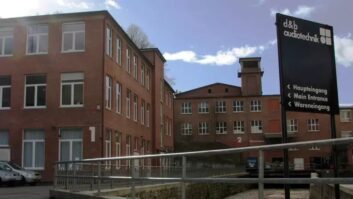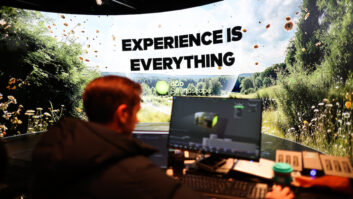Anyone who has spent any time dealing with audio in the digital domain has learned that below the “perfectly” calm surface lies a breeding ground for trouble that, upon occasion, makes one wish for the return of simpler analog days. One thing that we have all learned is that it’s all about money. We don’t expect the 16 preamps in a $3k console to sound as good as preamps that cost $1k each. Likewise, we don’t expect a set of D/A converters in a $1k studio-in-a-box to sound as good as a stand-alone converter that costs $5k. The only question, really, is, where do we throw the money?
Throwing your cash at D/A converters is a good idea if you need a pristine monitoring environment. Maybe you’ve just opened a 5.1 room and you really want to impress your clients. While surround mixing, you want to hear every low-level detail to make sure it’s where you want it to be. However, until the consumer base ponies up for equally spiffy converters, the audio will probably never sound better than it does in your studio. More to the point, great D/A converters also only make sense if you need or want to take a trip to the analog world — to that great-sounding analog mixing desk to any “old faithful” analog processors you may still like, or to a high-quality analog archive.
If those aren’t your concerns, then toss the money at the A/D converters with higher sample and bit rates first. You’ll hear the difference immediately, and the truth is painfully undeniable: It’s much better to know that your work could sound better through better A/Ds than to know you’re losing something right off the bat with “average” A/D conversion.
It is with that awareness that I approached the dB Technologies Conversion System, a system comprising individual modules that can be loaded a la carte into one or more single-rackspace power chassis. These are not vaporous software plug-ins; these are flesh-and-blood, rack-mounted hardware modules that accomplish a variety of analog and digital chores. Multiple chassis can be chained to provide a synchronized multichannel system.
The single-rackspace 4496 power chassis ($895) provides power, fan and I/O connectors. (The fan can be disconnected in most cases.) Into that five-slot frame, you can load any of six modules: M•SYNC-1 ($369), sync module; M•AD-824 ($1,495), a 2-channel A/D converter; M•DA-824 ($1,345), a 2-channel D/A converter; M•DD 1-2 ($495), a single-to-dual AES translator; M•DD 2-1 ($495), a dual-to-single AES translator; and M•BY2 ($695), an up-sample/downsample converter.
The M•SYNC-1 module, with a pair of rear-mounted I/O BNC connectors and 2x frequency switch, provides internal, AES or wordclock sync options. The front panel of the M•SYNC module offers switching for 44.1, 48, 88.2 and 96 kHz. There’s also a Wide/Narrow toggle switch; Wide for varispeed operations, Narrow for locking to signals within ±150 ppm. Narrow lock results in reduced jitter when operating with a single sample rate. A M•SYNC module must be used if a M•AD-824 converter is in the rack, or to sync a series of racks. When reading an external source through its rear-mounted BNC connector, the M•SYNC-1 can read varispeed sample rates between 40 to 54 kHz or 80 to 100 kHz.
The M•AD-824 2-channel A/D module was the most interesting to me. Analog connections, via XLR, can be balanced or unbalanced, and internal jumpers allow modification for pin 2 or pin 3 high connections. The M•AD-824 operates at 24, 20 or 16-bit modes. The LED meters are very precise at the top. A separate LED represents each dB from -9 to 0 dB. The reference level is also adjustable from -10, -12, -14, -16, -18 or -20 dBFs. Front panel 20-turn pots are used to align the audio with the reference levels. For systems with more than two A/D modules, one must be set as master and the others as slaves via internal jumpers. Masters are easy to identify during startup because their -9dB LEDs flash, while the slaves do not.
The A/D module also features both analog hardware-based soft saturation and non-overloadable digital software saturation, and a choice among dither or two flavors of Acoustic Bit psycho-acoustic enhancement. The analog and digital saturation circuits, with their adjustable thresholds, provide a wide variety of the same sort of density and squeeze I’d normally associate with analog tape compression. So if you’ve been clinging to analog because you and your clients really enjoy smacking analog tape, you now have a worthy digital alternative.
The analog saturation circuit has an internal jumper that moves the threshold from -3 to -6 dBFs. Lower the threshold and the saturation circuitry has more effect on the audio. The digital soft saturation can be set to provide +6 dB of loudness, each of which has slightly different transfer curves. Whereas a typical compressor reduces gain changes in attack and release envelopes, the digital soft saturation algorithm works on each sample. All samples below threshold are amplified by +6 dB.
The M•DA-824 D/A converter has XLR outputs with balancing jumpers similar to those on the A/D module. A toggle switch on the front panel allows pin 2 or pin 3 operation. LEDs consist of a Lock light and indicators for 44.1, 48, 88.2 and 96kHz operation. A three-way Wide, Narrow and CrystalLock™ switch can be set Wide for varispeed operation — which comes in very handy when working on any film or video projects with pull-up or pull-down issues — and Narrow for reduced jitter.
CrystalLock™ activates a temporary buffer and special DSP to further reduce jitter on 2-channel sources. Got some old DATs that are getting funky? Try CrystalLock™. As CrystalLock™ looks at an incoming AES stream, its DSP measures the sample rate. The internal buffer captures the signal for about six samples. The DSP circuit changes the rate of the internal crystal to the exact frequency of the AES stream. Then the stream is reclocked to the crystal.
Output gain for each channel is front panel-adjustable from 0 to +24 dBu for balanced, and -6 to +18 dBu for unbalanced operation. A maximum of +27dBu balanced (for those situations where levels are hot and the next stage can handle it, like some Dolby encorders) can be achieved by removing two resistors from the board.
OTHER MODULES
In addition to the A/D and D/A converters and Sync module, dB Technologies has bidirectional solutions for those pesky two-wire AES/EBU, 88.2/96kHz bit-split situations where you want the higher sample rate, but your system tops out at 44.1 or 48 kHz. What the M•DD 1-2 splits in two, the M•DD 2-1 recombines. The M•BY2 synchronous upsample/downsample converter does 2:1 or 1:2 conversion for those 44.1 to 88.2 and 48 to 96kHz chores with a filter to get rid of frequencies above the Nyquist limits. It also comes in handy for people mixing at 96 kHz who need AC-3 files at 48 kHz and don’t want to make a second pass. The module has one input and two outputs, so it can also act as a digital distribution amp.
THE SOUND
At the head end, I used a Schoeps MK41 hypercardioid mic into an Aphex 1100 preamp with both analog and 48kHz, 24-bit AES outputs (and recently upgraded the op amp chips in front of the 1100 A/D converter). I then ran line out to the dB Technologies M•AD-824 analog input, and digitally out through a Graham Patten AES-DATS impedance and level converter to the S/PDIF (IEC) input of a Digidesign Digi 001 operating at 24-bit, 48kHz. A call to the local Digidesign rep confirmed that the S/PDIF TOSLINK ports and the rest of the Digi 001 could handle the 24 bits. This gave me the opportunity to compare the dB Technologies A/D converters with the Aphex 1100 and Digi 001 converters.
I used a Martin D28S acoustic guitar and recorded six separate tracks using the Aphex 1100 preamp. From the analog outs of the preamp, I first routed through the dB A/D with no effects, then with its Analog Saturation, then with Digital Saturation, then through the Aphex 1100 24-bit, 48kHz converter, with and without the Aphex MicLim feature. Finally, I plugged the Schoeps right into the Digi 001 preamp to test the Digi preamp and converters.
I monitored playback directly from the Digi 001 analog output, which, of course, meant its D/A converters. The Martin sounded very nice through the straight dB Technologies A/D converters. With Analog Saturation on, the top end got slightly softer — silkier. With Digital Saturation, the signal got at least 5 dB louder without over-driving, but the character of the sound — I’d call it density — increased. The audio was less silky, thicker, with a slight edge on top. Got clients who always want it loud? Go right for this setting.
The Aphex 1100 A/D was warmer, with slightly less top end as the straight dB. The Aphex with MicLim engaged sounded more like the straight dB, but was louder because I could kick the input sensitivity up another 3 dB and let the Aphex MicLim circuit prevent the digital overs. The Digi 001 preamp and A/D converter were my least favorite. The sound was noticeably edgier and less natural.
I then ported the tracks via S/PDIF to a new iZ RADAR 24 operating at 24-bit, 48kHz, and listened again in a different monitoring environment. With the RADAR D/A converters, the Digi 001 preamp A/D converter track transformed nicely from edgy to bright, but for the most part, the tracks began to sound more similar and better.
To check out the dB Technologies D/A converters, I patched the straight dB track out of both the RADAR analog and AES/EBU digital outputs. I connected the AES/EBU output to the dB Technologies D/A converter and compared both versions of the same track. Both sounded great, and, although there was a very minor difference, I could not describe it.
IN CONCLUSION
Without question, the dB Technologies A/D converters and D/A converters resulted in improved audio. The analog and digital saturation and other dither options give one the power to make louder sounds and to emulate analog tape compression. The D/A module’s ability to reduce jitter is also appreciated, as is the Wide clock for varispeed operation. The other modules are important parts of any studio’s digital toolbox until we’re all on the same 24/96 (or higher) single-wire digital “bullet train.” Having all of the modules in a coherent system is also a welcome idea. I think analog and digital saturation circuits are important enough to consider putting them in a separate D/A or D/D module so they can be used to process audio that is already in the digital domain.
dB Technologies Inc., dist. by Audio Intervisual Design, 1155 N. La Brea Avenue, West Hollwood, CA 90038; 323/843-1155; Fax 323/845-1170; www.aidinc.com.
Reach Ty Ford at www.tyford.com.
Spec Sheet: dB 4496 System
4496 PSU/Rack
Capacity: up to 4 modules (2/4/6/8 channels)
Input voltage: 90 to 264 VAC
M•AD-824 Stereo ADC
Noise: -118 dBFS ±1 dB (A-weighted)
Distortion: 0.00125% FS typical (1 kHz @ -1 dBFS)
Sample rate: 44.1/48/88.2/96 kHz
Varispeed range: 38 to 51kHz and 76 to 98 kHz
Channel separation: -100 dBFS (@ 1 kHz)
Flatness (±0.05dB) response: 10 to 20k Hz
Phase linearity: 2° (10 to 20k Hz)
Digital output: 16/20/24 bits, 110-ohm AES/EBU
Analog inputs: Balanced/unbalanced 12 to 24 dBu FS
Gain adjust range: +12 dB
M•DA-824 Stereo D/A
Noise: -110 dBFS (20 to 22k Hz unweighted)
Distortion: 0.002% FS (1 kHz @ -1 dBFS)
Sample rate: 44.1/48/88.2/96 kHz
Varispeed range: 32 to 100k Hz wide lock mode
Channel separation: -100 dBFS (@ 1 kHz)
Flatness (±0.05dB) response: 10 to 20k Hz
Phase linearity: 2° (10 to 22k Hz)
Digital input: 16/20/24 bits, 110-ohm AES/EBU
Analog outputs: Balanced (27 dBu max); unbalanced (21 dBu max)
Gain adjust range: 24 dB
M•Sync-1 Clocking Module
Internal crystal: 44.1/48/88.2/96 kHz
Varispeed range: 37 to 52 kHz and 74 to 100 kHz
External sync: Wordclock or AES



